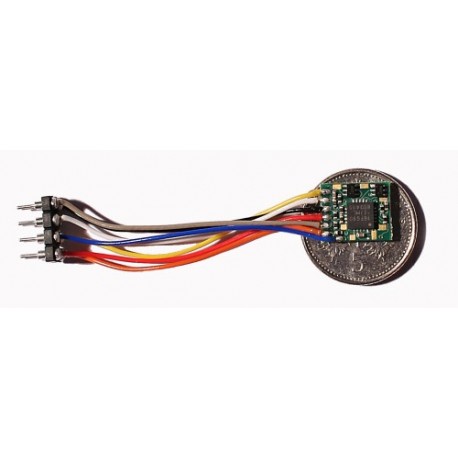No products
Product successfully added to your shopping cart
There are 0 items in your cart. There is 1 item in your cart.
Very Small Locomotive Decoder 2 Function
DCC22
Gaugemaster
Very Small Locomotive Decoder 2 Function
Most suited to OO/HO locomotives. Key features of this standard decoder include smooth operation, 14/28 speed steps, plug and play, transponder id-equipped, all mode programming, decoder reset CV, motor isolation protection, advanced consisting, 2 and 4 digit addressing and DCC compatability. this decoder is rated at 1 amp (2 amp peak) with 2 functions at 0.5 amps and measures 10.6 x 8.7 x 2.86mm.
This product is out of stock
| Scale | Suitable for several scales |
More info
Very Small Locomotive Decoder 2 Function
Most suited to OO/HO locomotives. Key features of this standard decoder include smooth operation, 14/28 speed steps, plug and play, transponder id-equipped, all mode programming, decoder reset CV, motor isolation protection, advanced consisting, 2 and 4 digit addressing and DCC compatability. this decoder is rated at 1 amp (2 amp peak) with 2 functions at 0.5 amps and measures 10.6 x 8.7 x 2.86mm.
One of the considerations when contemplating changing your layout control from analogue to Digital Command Control (DCC) is the cost. You will need a decoder in every locomotive that you wish to run on your layout. Thus, it you have many locomotives that need one, the cost can quickly mount up. A decoder receives instructions from the DCC base station (the digital equivalent of a analogue controller, also referred to as a ‘Command station’) and responds accordingly. Examples of these instructions are ‘turn the running lights on’, move forward at speed step 10’, ‘sound the whistle’, and many more) The decoder is given an identity (known as an address) so that it can accept only those instructions that are meant for it. This makes it possible to individually drive each locomotive on your layout without the use of track section switches.. There are many locomotive decoders to choose from. They vary in size and shape, power handling, the number of facilities (known as functions), the type of interface (how it physically connects to the locomotive circuit board. and price. Here from Gaugemaster we have a miniature locomotive decoder suitable for N gauge and small OO/HO locomotives that have an 8-pin (known technically as an NEM652) socket. The decoder has the matching plug already attached so it can simply be plugged in once you have gained access to the interior of the target model. You can have piece of mind in knowing that this decoder will work with all DCC base stations that conform to the standards for DCC as defined by the National Model Railroad Association (NMRA), which in practice means all of them. The decoder features speed stabilisation to enhance slow-running qualities, plus 2 function outputs which are intended for control of head and tail lights and which can handle 0.5amp each. It can handle a total of 1 amp (2 amp peak). Use with Hornby R8214 Elite DCC controller, or Bachmann 36-500 E-Z Command Digital Control Centre, or any NMRA compatible base station.




